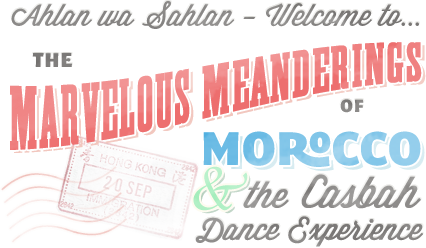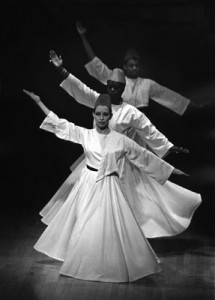Why & How My Life’s Career Came About
My career in dance started on the radio.
While channel surfing one afternoon, I stumbled across a weekly Arabic radio program called “Middle Eastern Melodies”. I couldn’t believe my ears, this was wonderful! Soon I found two other stations and three days out of the week the world stopped while I drifted on the waves of ouds, kanoons, nays and violins, while my heart pulsated to the beat of the darbuka.
This music spoke to a very special place in my soul. For three years I absorbed it, until it’s character became part of my nature and yet I could not express it physically, which really annoyed me.
I grew up in the Bronx in the early days of the Hip-Hop culture, which originated there in the mid to late 70’s. Rap music is one of its products, in which dancing is central.
If you didn’t know how to dance you were a social outcast. Even worse was not knowing how to dance well. Therefore, we all practiced the latest dances, as if we were professionals, until we perfected every move. We prided ourselves on being able to dance to any type of music, on the beat, gracefully!
My natural response to rhythmic music was to dance, yet I didn’t know how to do it to this music, or how men were supposed to dance to it. I knew about “belly” dancers, I’d even been to a few concerts I’d heard advertised on the music programs, but I’d never seen any male dances or dancers.
One day I was speaking to my history professor about my love of Arabic music and how feminine women were when they danced to it, to which he replied, “Oh, but the men dance the same way!” His area of specialization was Caribbean history, which mean that he had to go to Spain regularly to research in the old archives. When his work was finished, he took the ferry to Morocco and hiked through the Berber villages in the Atlas Mountains.
He spoke endlessly of his travels. Nevertheless, I didn’t believe what he told me about the dance. If it were true how come I never saw a male “belly” dancer?
Later that same year I saw a talk show, (I think it was Sally Jesse), which was about “belly” dancing and one of the dancers was a man, Amir, from Boston, (R.I.P.). He claimed he was of Armenian descent and had learned this dance form as part of his culture. I thought he was full of it, but my curiosity was aroused.
A week later I heard there was going to be a series of 3 concerts at the Riverside Church Dance Festival by Morocco and the Casbah Dance Experience, with a male dancer, Sergio. Halloween 1985 was the first time I saw real Mideastern & North African folklore, and a male dancer. It challenged every preconceived idea I had about Mideastern dance and culture.
However, skeptic that I was, I called Morocco the next day to grill her…and ask if I could buy another ticket, to which she replied, “If you’re a glutton for punishment sure!”
I wanted to dance to this music, but I was still unsure.
Despite this, a week later I called Morocco again. This time I wanted to know if men really did this dance *&* if she taught them, to which she replied, “Well, I don’t have any male students at the moment, but if you don’t have problems being the only male, I don’t mind – that is, if you really want to learn dance. If you aren’t serious, don’t bother to come!”
I was the only man in the class but I didn’t mind it at all. The women enjoyed the novelty of having a guy around and made me feel welcome.
I picked up the hip-work combinations readily. Many of them, especially the “figure eights”, were almost identical to movements of Reggae and Calypso that I grew up with.
But there were the other movements: undulations, hip circles and arm movements seemed next to impossible. I was 125 lbs, sway-backed & sunken-chested on top of it! It took Morocco two years to correct my body alignment. In the meantime, I practiced at home as often as I could, sometimes for hours in order to perfect my steps.
My dedication became apparent to Morocco. She took me aside, said I’d surpassed many of the students, who’d been studying far longer & invited me to sit in on her dance company’s rehearsals.
In May of 1986, I made my debut as the “Groom” in “Benediction & Betrothal” (a combination of the Guedra & Tissint Betrothal Dance), at a concert by Morocco & the Casbah Dance Experience for the United Nations, a small part, starting a career which is still growing eleven years later.
When I wasn’t taking class, I was doing research in the Lincoln Center Dance Library.
My family were Born Again Christians and weren’t exactly thrilled about what I was doing. It became apparent to me that I would face challenges from many people about the validity of this dance as a legitimate folk form, as well as the appropriateness of a man doing it.
I was determined to be able to completely & competently defend my position.
Performing was not enough: dispelling the myths and stereotypes surrounding the dance and cultures from which it came was even more important. I practically became a piece of furniture in the library.
Education became an essential part of my career. It was in Morocco’s school that I became a teacher: when I was no longer able to pay for classes, she allowed me to do the warmup in exchange.
I noticed there were some, who had problems following the class. I asked Morocco if I could break down some of the movements more finitely in her basic warm up. She asked me to show her what I had in mind and explained that her warm up was specifically organized, so the muscles were worked and warmed up in the proper anatomical sequence.
She improved my “improvements” and our current warm up is the final product. If you’ve had a class with either of us you know it’s a workout in itself!
Morocco wanted me to start my own beginner class. Although I was unsure at the time, she had confidence in my abilities.
She’s been there to offer advice and encouragement whenever I wanted to quit. She said I had unique insight and patience when it came to teaching beginners. I remember what it was like to be a beginner and the questions and difficulties I had.
I also realized that like myself, most people’s experience in public school was very “toxic”. Instead of being encouraged, I was discouraged and often ignored. If I didn’t grasp a concept fast enough, I was made to feel stupid. If I asked for explanations, I was told I should have been paying attention when the teacher said it the first time.
Years later, I understood this was not teaching. Nevertheless, this is what most people have been conditioned to accept as education and this is the mindset they bring to class. If they don’t master a step immediately, they blame themselves and soon “burn out”.
Before I start a class, I first reprogram their minds. I tell them I don’t expect them to know the dance, I don’t care if they’re not “good”. If they already knew how to dance, they wouldn’t need me. I’m a teacher and my job is to teach, which means giving them knowledge that they don’t have.
I empower them by saying: “if you don’t understand something, ask”. That’s what they’re paying for. There is no such thing as a stupid question. Also making mistakes is part of mastering a new skill.
Think of all the new skills a child learns in the first two years of life. If there was someone giving an “F” every time they fell or mispronounced a word, who would walk or speak? We would stop trying for fear of getting it wrong.
Learning to dance is a process, not an event. There are some things you get quickly & others that require more time and attention. It’s normal to make mistakes and have difficulties.
I have four rules in my classes:
- Never say I can’t, unless you have some physical handicap;
- Keep moving, even if you feel like you have three left feet: your body needs time to figure out what you’re trying to tell it to do, (it never did that before, so give it a break!);
- Even if you make a complete fool of yourself, when the song is over, pose prettily;
- If everything you tried failed, there’s the eleventh commandment: If they can’t take a joke screw’em, tomorrow’s another day!
I believe we were put in this world to evolve spiritually. To do this we’re given challenges and difficulties to learn from and overcome.
God, Goddess, the Universe, whoever, out of love gave us music, dance and art to comfort us in hard times and to release stress. I was given a gift to help those around me, to spread joy, to encourage people, whether it be through dancing for them, or teaching them, helping them feel better about themselves and their bodies in the process.
I don’t do it for my ego, but from love and a desire that people leave feeling better than when they came. I hope that one day I’ll get the opportunity to share that love with you.

